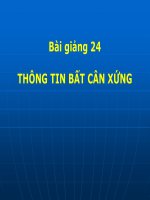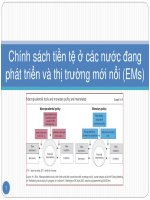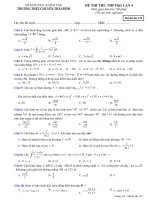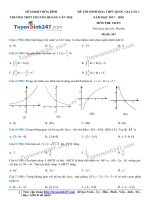Cs224W 2018 51
Bạn đang xem bản rút gọn của tài liệu. Xem và tải ngay bản đầy đủ của tài liệu tại đây (6.07 MB, 8 trang )
Via: A Prerequisite Projection Graph for Course
Sequence Discovery
Geoffrey Angus
Richard Diehl Martinez
Computer Science
Stanford University
Computer Science
Stanford University
Email: gangus @stanford.edu
Email: rdm @stanford.edu
Index Terms—Causal Inference Sequence, Temporal Networks,
Bipartite Graphs, Network Analysis.
I.
INTRODUCTION
Every year, more than 1400 students enter Stanford University as first-year undergraduates. To help these students,
Stanford provides an array of tools to advise students on
how to effectively structure their course progression. Since its
inception in 2014, Carta! has emerged as one of the primary
tools at students’ disposals to structure their academic pathway
through Stanford. The goal of Carta, as expressed in their
mission statement, is to help students make informed decisions about their classes by evaluating how students consider,
choose,
and
sequence
courses.
However,
few
of Stanford’s
academic resources give students access the academic pathway
information necessary to contextualize local decisions at the
course enrollment level. By analyzing recurrent patterns in
the historical enrollment data of students throughout their
academic careers, we propose a graphical representation of
course sequences that enable us to extract patterns in student
behavior regarding course enrollment decisions.
II.
PROBLEM
FORMULATION
The goal of our project is to analyze historical student
behavior in course enrollment in order to generate a directed
graph that accurately models how courses are typically sequenced. To do this, we must demonstrate that our graphical
representation of the sequential relationship between classes
is representative of actual observable dynamics at Stanford.
This assumption will enable us to further explore patterns in
the course data uncover latent relationships between courses
in our so-called course sequence graph. Moreover, we will
demonstrate that the course sequence graph enables us to
recover and study global properties of course sequences such
as academic majors, and knowledge specializations.
II].
RELATED
WORK
Our literature review centered primarily on unsupervised
learning algorithms to detect latent structures in networks.
Part of our goal in creating a course sequence graph is the
ability to detect the presence of community structures between
'
courses. Karrer et. al’s Stochastic blockmodels and community
structure in networks propose a degree-corrected stochastic
block model that outperformed those block models that did
not account for degree [1]. They propose this algorithm in
order to correct for the inaccuracies
that, at time of writing,
plagued the performance of stochastic block models on real
world networks. We posit that mandatory courses taken in the
first two years at Stanford will present problems similar to
those found in the the real world networks described in the
paper.
Another look into the augmentation of traditional stochastic
block models can be found in Aicher et. al’s paper Learning latent block structure in weighted networks. This paper proposed
a Weighted Stochastic Block Model, for the task of discovering
structure in information that would otherwise be lost when
weights in a real world network are discarded or thresholded.
The projection task will rely on co-enrollment frequency in
order to classify prerequisite relationships, therefore there will
likely be a weighted signal produced for each class relationship
that signifies a confidence in prerequisite relationship.
In addition to finding community blocks within course sequences, we are interested in leveraging the temporal nature
of our dataset. That is, given that a set of students
that have
taken a set of class a certain number of quarters apart, what is
the probability that there exists some prerequisite relationship
between those classes. Chang et al. have explored a similar
problem in predicting temporal bipartite graph projections
for
online
social
networks
[2].
The
authors
use
a method
known as relational topic modeling to draw edges between
groups of nodes that share similar local structures. Chaturvedi
et al. frame the problem of link prediction in a similar
manner, but employ a kernalized SVM through which they
pipe information about a node’s local structure [4].
In addition, we reviewed literature regarding the topic of
algorithmic course sequencing in higher education. Doing so
enabled us to cross examine our methodology and gain a more
holistic insight into the field. One of these papers was Xu et.
al’s Personalized Course Sequence Recommendations
[5]. The
authors of this paper frame the task of developing an optimal
sequence of courses as a task of constructing an optimal policy
such that a students time until graduation is minimized and
their GPA ¢ is maximized. The optimization algorithm used in
order to do this is a variation of a Forward-Search Backward-
Induction algorithm.
A.
Enrollment Data
1) Data Description: The dataset we use to build our
graph for mapping sequential relationships between classes
was obtained directly from the Stanford Carta Lab. This
dataset contains anonymized class enrollment data for over
52,000 students (both graduates and undergraduates) who were
enrolled at Stanford during any time between Fall 2000 and
Fall 2018. Most importantly for our purposes, the enrollment
data gives us individualized student data, allowing us to
aggregate the course sequence history of each student in the
dataset.
2) Data Preprocessing: Data preprocessing primarily involved the separation and extraction of the information required from the Carta dataset— that is to say, for each
student, all classes paired with their quarters of enrollment.
Student metadata was omitted and only classes in our dataset
marked completed (classes not dropped by the student during
the quarter) were included. We then built a sequence matrix
representation of what we will call the Carta Network. This
can be interpreted as a bipartite, multi-graph that expresses
student enrollment in courses over time. This sequence matrix,
S, has the dimensionality |I/|x|C|, where M is the set of all
students and C is the set of all classes. An entry into the matrix
indicates which student took which class at which quarter in
their Stanford career. For instance if S;,; = 5 this means that
student 7 took class 7 during their 5th quarter at Stanford. This
sequence matrix enables us to discern the classes frequently
taken sequentially by students.
2) Data Preprocessing: In our later analysis we will leverage the course descriptions in order to generate a ’groundtruth’ for course sequences. Our insight for doing so was
that several course descriptions explicitly list prerequisites
for taking a particular class. Since these requirements are
explicitly enumerated by a teaching team, we can assume
that any courses listed in the prerequisite section of a course
description are accurate. In order to extract the prerequiment
section and the courses listed under this header we make use
of regular expressions. The regular expression extraction was
made difficult by the varying ways in which courses can be
referred
IV.
and recursive data strucIntroduction to time
and space complexity analysis. Uses the programming
language C++ covering its basic facilities. Prerequisite:
106A or equivalent. Summer quarter enrollment is
limited.
Fig. 1.
B.
Course Description for CS106B:
Programming Abstraction.
Course Description Data
1) Data Description: In addition to course enrollment
information, the Carta Team provided us access to a scraped
dataset of course descriptions from explore courses. In total,
this dataset contained roughly 29,000 course descriptions
across all majors. An example of an entry from the dataset
is provided in fig. 1, for the course CS106B: Programming
Abstractions.
As
a result, we
note that
GRAPH
CONSTRUCTION
1) Knowledge can both be learned and lost.
2) The probability of losing knowledge increases the more
time passes since that knowledge was gained.
3) A class A teaches a finite set of concepts to students.
This set of concepts collate into what we know to be
knowledge.
4) A class A may require students to have a prior understanding of another finite set of concepts.
5) For many pairs of classes A and B, there exist overlapping concepts that are taught or required in both of
these classes.
6) For many pairs of classes A and B, the concepts covered
in class A are required to complete class B.
7) If assumption 2 holds for a pair of classes A and B,
it is very unlikely that the inverse relationship holds as
well: that is to say that the concepts covered in class B
is not required to complete class A.
8) Given assumption 6, we can reasonably assume that a
class B will be taken after a class A for which the
relationship in assumption 2 holds.
data structures (such as stacks, queues, sets) and data-
directed design. Recursion
106A...).
In the following subsections we introduce several graphical
models that illustrate common course sequence structures.
Each of the subsections below are ordered by increasing
complexity in their representation of course relationships. We
constructed these baseline models in order to gain insight and
confirm some intuitions about the nature of the Carta network.
For the construction of these graphs we are guided by the
following first-principle assumptions regarding the nature of
classes and their content:
Abstraction and its relation to programming. Software
engineering principles of data abstraction and modularity. Object-oriented pro gramming, fundamental
tures (linked lists, trees, graphs).
to (i.e. CS106A,
even though this data provides us a ground-truth these values
may be noisy.
From these first principles we can reasonably assume that
all classes either have or do not have some prerequisite
relationship. We model this relationship between all classes
offered at Stanford, by denoting each class as a node in a
graph and each edge as a directed prerequisite relationship
between two classes.
A.
Carta Network
The Carta Network can be defined as a bipartite multi-graph
that models each student as a node and each class as a node. A
student node, s, and a class node, c, are then linked via an edge
e) if student s took
career. This bipartite
the sequence matrix
visualizations of the
a class
graph
which
data in
c at timestep ¢ of their Stanford
is a graphical representation of
will be used to generate basic
our final report.
B. Prerequisite Graph (Baseline)
After building a graph that maps the relationship between
student and classes directly, we explore how to model a
projection of this graph to establish relationships between
classes. For this task, we are guided by the aforementioned
first-principles. In particular, we make use of the sequence
matrix to establish a new, prerequisite score graph. We define
G to be a symmetric graph with dimensions |C|x|C|, where
Π1s the set of classes present in the dataset. Each entry
in the graph then establishes how often a class 7 was taken
after a class 2 in a directly preceding quarter. That is to say
G;,; = 2000 means that 2000 students took class 7 exactly
one quarter after taking class 7. We can derive this information
quickly from the sequence matrix. In order to then establish a
graph from this information, we can extract the top n entries
from the matrix G. This will return a list of n tuples that
represent the top n pairs of classes taken exactly one quarter
after the other.
C. Prerequisite Graph (Discounting)
One of the problems we encounter in our previous construction of a prerequisite graph is that this model does not account
for any relationship between courses that have been taken more
than one quarter apart. That is to say, we would like to account
for a sequential relationship between classes that have been
taken more than one quarter apart. However, we posit that the
more time has elapsed between a student taking two classes,
the less likely it is that the two have a prerequisite relationship.
This insight follows fairly simply from our assumptions 2 and
8 gathered from first-principles. That is to say, if a class B
directly requires information from a class A then class A and
B should be taken within a close time interval of each other.
Otherwise, the information from class A may be lost over time
and be of less use to class B. These guiding principles thus
lead us to conclude that we would like each entry in our graph
G to also include a discounted factor for classes 7 and 7 that
have been taken sequentially, but more than a quarter apart”. In
our implementation, we use a discounting factor of 0.9 (found
to work best empirically) that is exponentially discounted as
the time between taking class j after i increases. Thus each
entry G;,; is computed as
Gi„ = À(0.9)
562) Tuy vị.
ses
Where
we
let
that computes
S
be
all
sets
the numbers
be
a function
of quarters between
of
students,
¢,
student s’s
enrollment in class j after i, and [,.;_,; be an indicator variable
for whether a student took class 7 after class 7. Having made
these changes, however, we note that we have yet to account
* 12-013-0363-3
for an additional factor. Given our assumption 7, we should
not expect to see any bi-directional relationship between two
classes. That is to say, a class i and 7 should not list each
other as prerequisites. We would thus ideally like to penalize
the sequential relationship between a class i and 7 whenever
we observe a large number of relationships between 7 and
a as well. We can also make the inverse argument as we
did before, that the further apart a sequential relationship is
observed between a class 7 to i the less it should penalize the
sequential relationship between 7 and 7. We can now make
this simple change, to obtain our final graph G, where each
entry in G is now given by:
Gij
=
S09)
OP Tag
99 — SG.)
ses
GF) Tag oe.
ses
As before, in order to now establish a graph from this information, we can extract the top n entries from the matrix G. This
model would seem to capture the semantics
relationships more soundly then our baseline.
D.
of prerequisite
Prerequisite Graph (Discounting, Normalized)
Although, the prerequisite graph established in the previous section successfully accounts for dynamic sequential
class relationships, it fails to normalize for the number of
students that have taken a particular class. Intuitively, our
current model fails to accurately balance out the sequential
influences between classes, since classes with large enrollments, like CS 106A, will naturally always yield the most
sequential relationships with any number of different classes,
no matter if they should be related sequentially or not. To
account
for
this
normalization,
we
divide
each
entry
in
a
certain row 7 of the prerequisite scores matrix’ G by the
square root of the enrollment of course ¡. That is what
Gnormalizea|?, J] = Gt, j]/./enrollment(z). We find empirically
that dividing by the absolute value of the enrollment of class
i penalized large classes too much. Mathematically, we can
now
express
our normalized
matrix
G,
Ghormalizea,
aS Simply
Gormatizea = D~'/?GIgiag. Where D~!/? is a diagonal matrix
with the enrollment data of each class i on the i*” entry along
the diagonal, G' is the previous discounted scores matrix and
Igiag is an identity matrix.
E. Discounting, Learned
After running experiments on the model described above,
we determined that a learned decay could lead to even more
promising results. We propose an algorithm that uses automatic differentiation via backpropagation to learn some scaling
coefficient for the sum of enrollments for each timestep. In
our proposed Learned Discount model, we calculate scores
for each of the class pairings 7,7 in prerequisite adjacency
matrix G with the following formula:
Gij =
T
» 6;(|enrolled after i timesteps|)
¿=—T
Top 1000-Edge Weights (Discount)
Top 1000-Edge Weights (Baseline)
4000
Carta network
Null model
3500
Top 1000-Edge Weights (DiscountNorm)
Carta network
Null model
5000
Carta network
Null model
3000
3000
2000
Score
Score
2500
1500
2000
1000
1000
500
0
200
400
Edge Rank
600
800
1000
0
200
400
Edge Rank
600
800
1000
0
200
400
Edge Rank
600
800
1000
Fig. 2. A comparison of the weights of the top one thousand of one hundred million edges generated by each of the scoring mechanisms. When the scoring
mechanisms are applied to both the Carta network and the null model, it is evident that there are strong behavioral patterns among students that imply
prerequisite relationships between courses. The exponential relationship evident across all 3 models tells us that prerequisite relationships only exist between
a small subset of class pairs, confirming our intuition.
We derive this formula from the notion that we can re-express
the score calculation presented for Normalized Discount as the
following:
và
G¡j =À_`(0-9)#(|enrolled after k timesteps|)—
k=1
—1
» (0.9)#(lenrolled after k timesteps|)
k=—T
By learning parameter vector 0, we replace the decay factor
used above with a set of coefficients learned from features of
the input tensor. In order to do this, several modifications had
to be made to the process of graph generation. Specifically,
we reformulated the problem as a regression task that
trained these weights to find a best fit between our predicted
prerequisite adjacency matrix and a ground truth adjacency
matrix.
First,
we
the shape
T
created
is the maximum
in two
a
|C|az|C|zT,
classes
non-discounting
where
delta
of interest.
in time
That
3-D
tensor
M
of
C is the set of classes and
between
is to say,
the
an
enrollment
entry
Mj;
is
the number of students who enrolled in class 7 after class 2
with a timestep delta k. This allows us to record counts of
enrollment as well the amount of time between enrollments
without scaling. We then learn some set of parameters
0 € R??+!. Note that we learn 27 + 1 parameters in order
to accommodate for the sometimes relationships penalized in
the Normalized Discount algorithm presented in section IV,
part D.
A loss function and some notion of ground truth was
necessary in order to learn these parameters. We constructed
an adjacency matrix using the ExploreCourses
course
descriptions as the ground truth (see section III, part 2),
utilized Mean
Squared Error as the loss function, and utilized
the Adam optimization function in order train our model as
proposed by Kingma et. al [6].
We refrained from training
the degrees of freedom of our
model does not simply overfit
We deviate from the traditional
because we are solely interested
model to our dataset and not in
to unseen data.
more parameters to limit
model and ensure that the
to the ground truth results.
machine learning paradigms
in the objective of fitting the
the objective of generalizing
F. Null Model
The null model is a graph built by randomly generating
edges for the Carta network. The underlying sequence matrix
used to build this graph is replaced by a randomly sampled
series of data. For each student we assume that the student
selects four classes at random for each quarter they attended
Stanford. The null model also makes the assumption that all
students attend Stanford for 12-quarters (4 years) which is
a reasonable approximation of the length of time an undergraduate student attends Stanford. Additionally, we assume
that for each quarter a student takes exactly 4 classes which
are sampled randomly without replacement from all of the
available courses at Stanford. The sample probability of a class
is directly proportional to the total number of students that
have enrolled in that course since Fall of 2000. To obtain a
probability we then divide this total count by the total number
of students that have been enrolled in any Stanford class since
Fall of 2000. By randomly assigning classes to students over
12-quarters, we can simulate a series of student enrollment
data with which we will build our null model. This simulated
data
will be
stored
in a null
sequence
matrix,
ŠS„„¡;, which
will be passed to the algorithms that build the prerequisite
projection graphs. As we do before, we can now plot the
sequence scores to determine the optimal number of nodes
to include in our graph. Running the DiscountNorm algorithm
on both the Carta network and the null model and observing
the top 5000 edges ranked by generated prerequisite score,
we observed that n = 1000 would provide us with the most
interesting results of both projections.
Degree Distribution in Ground_Truth Preqrequisite Graph
10?
Degree Distribution in Discount Preqrequisite Graph
Proportion of Nodes with a Given Degree (log)
Proportion of Nodes with a Given Degree (log)
Proportion of Nodes with a Given Degree (log)
in
10 Degree Distribution in Discount-Normalized Preqrequisite Graph
Node Degree (log)
The
109
Node Degree (log)
10' 2 Degree Distribution in Discount-Learned Preqrequisite Graph
Proportion of Nodes with a Given Degree (log)
10?
10°
Node Degree (log)
10?
4
M
10°
lọt
Node Degree (log)
102
Fig. 3. The degree distributions found in the ground truth prerequisite graph (shown here in red) and three of the proposed graph projection algorithms—
Discount, Normalized Discount, and Learned Discount. We note here that they have similar forms, revealing that there are some courses that act as prerequisites
to many
other courses.
V.
RESULTS
& DISCUSSION
Top 20 Modularity Scores (by Major) on 1000-Edge Graphs
We partition our results section into two parts, the first sec-
tion being a discussion about the experiments run to confirm
a network exists in the sequence data and the second section
being a discussion of our proposed projection algorithms
relative to our notion of ground truth, the prerequisite graph
generated from the ExploreCourses course descriptions.
in
the
Carta
0.035 +
Carta - Discount
Carta - DiscountNorm
0.030 +
null - Baseline
null - Discount
o
null - DiscountNorm
5 0.025 4
a
so
=
We confirmed a set of intuitions about the structure of
the real-world network before transitioning into evaluating the
accuracy of our prerequisite projection graph.
1) Edge Score Distribution: One task was to discern
whether or not clear temporal structure existed in the realworld network. Specifically, we looked to observe the distribution of edge scores. We hypothesized that the real-world
network would produce few, high-scoring directed edges and
a vast number of low-scoring directed edges. This would
that,
Carta - Baseline
= 0.020 4
A. Null Model Comparison
confirm
0.040 +
network,
there
are
strong
rela-
tionships between courses with prerequisite relationships and
no relationship between courses otherwise. We see in Fig. 2
a comparison between the preliminary scoring mechanisms
as they are applied to the real-world network and its null
model equivalent. The structure of the network is evident
we see here that when applied to the real-world network,
each of the three scoring mechanisms demonstrate a clear
exponential relationship between the score and ranking. When
the mechanisms are applied to the null model, we observe a
near uniform distribution of the scores between the edges. This
is a strong signal that temporal dependencies exist in the realworld network, which confirm our intuition that a prerequisite
structure can be drawn out of the Carta network in the way
that we have defined and constructed it.
2) Academic Major Modularity: Another feature which
further reaffirms our belief that a latent prerequisite structure
in the Carta network exists is that we can observe higher
modularity of sets within academic majors. We hypothesized
that prerequisite projections
created with
the scoring
mechanisms defined above would lead to the observation of
communities. Intuitively, this can be interpreted as students
taking courses in some sequence in order to complete
academic major requirements. In Fig. 4, we show that this
8 0.015 4
=
0.010 +
0.005
\
+
—
0.000 4
T
2.5
T
5.0
T
7.5
T
10.0
T
12.5
Cluster (major) ranking
—
T
15.0
T
17.5
T
20.0
Fig. 4. The modularity scores of the top 20 most connected majors in the
networks generated by our three preliminary prerequisite projection algorithms
on both the Carta network and the null model. High major modularity confirms
that students complete major-specific sequences during their time at Stanford.
Of the top 20 sampled from the Carta Network, approximately two-thirds
across all projections were STEM majors.
phenomenon does indeed express itself in our projections
across the first three graph generation algorithms proposed—
the baseline,
Discount,
and
Normalized
Discount.
The
chart
plots the modularity of the most modular sets where the nodes
of each set are grouped solely by academic major. The edges
used were simply the top-1000 edges as determined by the
scoring mechanisms, here evaluated in an unweighted manner.
The two experiments
explained above
showed
strong
signal that there indeed existed latent structures within the
Carta enrollment data that signified the possibility of crafting
a prerequisite projection graph. Therefore, we moved forward
with two more experiments that incorporated a notion of
ground truth to our problem formulation in order to guide
our decision making process to create a more accurate
representation of the relationships found in the dataset.
45
_Zscore of Motif Indices in Ground_Truth Preqrequisite Graph
1
2
3
4
5
6 7 8
Motif Index
9 10
11 12 13
Zscore of Motif Indices in Discount Preqrequisite Graph
1
2
3
4
5
6 7 8
Motif Index
9 10
11 12 13
3Fcore of Motif Indices in Disc
1
2
3
4
5
Grap
6 7 8
Motif Index
9
10
11 12 13
score of Motif Indices in Discount-Learned Preqrequisite Graph
1
2
3
4
5
6 7 8
Motif Index
9 10
11
12 13
Fig. 5. The motif distribution for the ground truth prerequisite graph and three of the proposed graph projection algorithms— Discount, Normalized Discount,
and Learned Discount. Note that the motifs are similarly over and under represented in both of the graphs.
B. Performance Evaluation
In the previous subsection we conducted a preliminary
analysis of our predicted subgraphs against our null model.
In this subsection and in the following, we will conduct
further analysis of the local and global structural similarities
between our generated predicted course sequence model and
our generated ground-truth sequence data. Using the course
description data (see section III, part B), we can create a
*>ground-truth’ course sequence graph. As before, each node
in this graph represents a particular course, and an edge is
drawn between courses for courses listed as prerequisites in
the course description.
1) Degree Distribution Comparison:
We first explore
global structural similarities by analyzing the node degree
distributions of our generated models against the distribution
of node degrees in the ground-truth graph. In figure 3 we
illustrate the varying degree distributions between the different
types of graph projections we generate against the distribution
of the ground truth model. In each of these we observe a
roughly exponential relationship between the node degree and
the count of nodes with this degree. Moreover, we observe
that the highest node degree is roughly the same across the
models. This suggests courses acting has prerequisites for
many courses are present in both our predicted projections
and in the ground truth projection. As a result, on a global
scale both the ground-truth graph and our predicted models
show similar structures.
2) 3-Motif Distribution Comparison: In this section, we
analyze local structural similarities between our generated
course sequence graph and the ground truth graph. We do so
by enumerating the occurrence of motifs of size 3 in each of
our generated graphs. Refer to figure in our appendix for the
indices which correspond to the observed motifs of size 3. In
figure 7 we illustrate the varying motif distributions between
the different types of graph projections we generate. Notice
that the ground-truth model lists a particularly high incidence
of motifs
1 and 5. Qualitatively,
this observation
seems
rea-
sonable if we consider how courses sequences are structured.
Motif 1 illustrates the example of a course being required as
a prerequisite to two others. This makes sense since a large
amount of courses list introductory classes as prerequisite (e.g.
many courses require students to have taken MATH 51 as a
basic linear algebra course). Motif 5 similarly makes intuitive
sense, since there exist courses (particularly in the School of
Engineering) that have several requirements which themselves
have some prerequisite structure. For instance, CS 161 lists
both CS 109 and CS 106 as prerequisites, but CS 109 also
requires CS 106 to have been taken beforehand.
With the introduction of discounting into our course sequence
model,
we
observe
that
both
motifs
1
and
5
are
detected
in large proportion by our model. Notice, however, that
this model also has a considerable occurrence of motif 6.
Intuitively, motifs 5 and 6 are very similar, the only difference
resulting from the fact that in motif 6 both of the classes which
are required by a third class have some mutual requirement. In
the context of course sequences, however, we would hope to
not see this sort of relationship frequently since there should
not exist mutual prerequisites between courses. Fortunately,
the discount normalized model no longer shows the occurrence
of motif 6, but still a very pronounced occurrence of motif
5. Unfortunately, we loose the recovery of motif 1. It makes
sense that we do not observe motif 6 in this model, since
we explicitly penalize bi-directional edges (i.e. courses that
mutually list each other as requirements). In our final model,
where the discounted factor has been learned by an attentionbased neural network, we are again able to recover both the
common presence of motif 1 and 5. Interestingly, however, this
model also shows a large degree of motifs 6, 11 and 12. The
frequency of these later motifs may be due to the fact that the
neural network approach does not have a notion to penalize
the co-occurrence of bi-directional edges. Instead, the network
has to learn these intuitive heuristics. In our case, it is not able
to do so, perhaps because it is limited by the amount of data.
3) Qualitative Analysis: In addition to providing the aforementioned quantitative arguments, we have provided samples
of the top 16 sequential course relationships returned to us by
our final course sequence graph, ordered in decreasing order
of sequence score in Fig. 6. Notice that we are able to recover
some well-known course sequences offered at Stanford, such
at the introductory CS sequence (CS 106A — CS 106B),
the introductory economics sequence (ECON 50 — ECON
51) and the introductory physics sequence (PHYSICS 41 >
PHYSICS
43).
Note
that there
are several entries
that show
an almost “interchangeable” prerequisite relationship between
certain courses, particularly in the HUMBIO department. We
| Previous Course | Next Course
PWRI
HUMBIO3A
HUMBIO3B
HUMBIO3B
HUMBIO3A
CHEM33
CHEM31A
HUMBIO2B
HUMBIO2A
HUMBIO2A
HUMBIO2B
CS106A
CHEM35
CHEM31B
ECONS0
PHYSICS41
Sequence Score
PWR2
HUMBIO4A
HUMBIO4B
HUMBIO4A
HUMBIO4B
CHEM35
CHEM31B
HUMBIO3B
HUMBIO3A
HUMBIO3B
HUMBIO3A
CS106B
CHEM 131
CHEM33
ECONS1
PHYSICS43
|
[5] Xu,
49.86
49.06
48.67
48.56
48.36
46.71
45.28
44.11
44.02
43.99
43.58
42.80
41.85
41.11
41.06
37.74
CONCLUSION
We have demonstrated that there are latent structures embedded in the Carta enrollment data. We first generated a bipartite graph from the raw data and then constructed a projection
that captured prerequisite relationships between classes using
student enrollment behavior during their time at Stanford. Our
report also outlines a method with which neural networks can
learned to recover course sequences from temporal data via
an attention layer over the temporal dimension. These results
were validated by comparing the predicted sequence structure
of our models with existing, ground-truth course sequences.
Future work may want to explore this later analysis in more
depth, by leveraging more complex networks like LSTMs
and Transformer Networks which incorporate notations of
temporal sequences.
{1] Brian
blockmodels
Review E.
Karrer
BIBLIOGRAPHY
and Mark
and community
EJ Newman.
2011.
Stochastic
structure in networks. Physical
[2] Chang, J., and Blei, D. M. 2010. Hierarchical relational
models for document networks. The Annals of Applied Statistics 124150.
[3] Christopher Aicher, Abigail Z. Jacobs, and Aaron
Clauset. 2014. Learning latent block structure in weighted
networks. Journal of Complex Networks.
[4] Snigdha Chaturvedi, Hal Daume
and
Mihaela
[6] Kingma, Diederik P., and Jimmy
discovered that this was because of high co-enrollment at the
instructors’ behest.
VII.
Xing,
Van
Der
Schaar.
Ba. ”’Adam: A method
for stochastic optimization.” arXiv preprint arXiv:1412.6980
(2014).
Fig. 6. The top 16 edges ranked by the score calculated by the DiscountNorm
prerequisite projection algorithm on the Carta network. We observe that
this algorithm captures relationships in course sequences taken heavily by
underclassmen.
VI.
Jie, Tianwei
*Personalized course sequence recommendations.”
IEEE
Transactions on Signal Processing 64.20 (2016): 5340-5352.
III, Taesun Moon,
and
Shashank Srivastava. 2012. A topical graph kernel for link prediction in labeled graphs. In Proceedings of the International
Conference of Machine Learning.
AZ 2,0”
2202022









